Dry shade is a problem that many gardeners struggle with. While sun-loving flowers are bursting with colorful fragrances and dramatic foliage, shade-dwelling plants are often the unsung heroes that remain unseen and must be sought out. Add in that you also have to deal with drought conditions, and you'll be left scratching your head trying to find planting ideas for reliable drought-tolerant plants.
The good news is that there are plenty of captivating foliage options that gardeners can try. Bringing seasonal colour, structure and texture to dingy, dry areas beneath trees and shrubs, or in the shade of garden buildings, will not only enhance the garden's appearance, but will also increase the garden's biodiversity.
Here, our experts share their favorite drought-tolerant, shade-loving plants and the best ways to grow them.
(Image credit: Lee Hyuck via Getty Images)
8 drought-tolerant plants perfect for shady gardens
Shade-loving perennials can handle occasional drought without issue. Young plants will need regular watering at first, but once established, they can go without water for short periods without any long-term damage.
The evergreen climbing plant Arabian jasmine (Jasminum sambac), the bulbous lily plant Ornithogalum umbellatum, and the attractive umbrella plant Cyperus alternifolius l are all great choices. Here are eight more recommended plants that are perfect for dry, shady gardens.
1. Epimedium
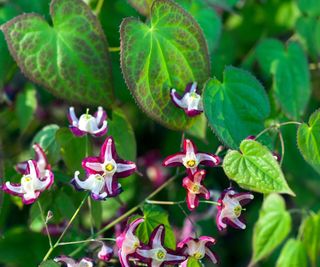
(Image courtesy of Alamy/ Botany vision)
Popularly known as barrenwort, this ground cover plant is hugely underrated. With its profuse heart-shaped leaves, green, often with a hint of red or rust, and delicate flowers dancing on thin stalks, it's a mesmerizing plant. It tolerates deep, dry shade, making it extremely useful for greening up those awkward, gloomy spots under trees and shrubs.
There are over 30 different epimedium varieties to suit almost any spot in the garden, including the stunning Barrenwort 'Amber Queen' variety available from Nature Hills – deciduous, semi-evergreen and evergreen.
This plant grows best in USDA hardiness zones 5 through 8 and not only provides a valuable early source of pollen and nectar for pollinators, but also helps increase biodiversity in your garden by providing refuge for invertebrates and amphibians.
2. Fatsia
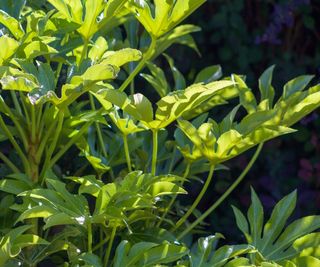
(Image courtesy of Alamy)
One of the most beautiful evergreen plants, the fatsia is beloved by landscapers and gardeners for its glossy, palmate leaves and stately shape.
It takes up to 20 years to reach a height of 13 feet, making it perfect for a dry, shady spot in your garden and requiring very little care once established. It grows best in USDA hardiness zones 8-11.
Its large, striking green leaves give it a tropical feel, and in autumn it produces small white flowers and black berries.
3. Pyracantha

(Image courtesy of Alamy/Deborah Vernon)
One of the best landscaping shrubs available, this hardy, hardy plant is perfect for adding a colorful hedge. With its bright orange berries and nasty thorns, pyracantha, also known as firethorn, is beloved by birds and wildlife.
The plant is fairly tolerant of salinity and grows well in sun or partial shade in USDA zones 6 through 9. Firethorn plants can be found at Nature Hills.
With white flowers blooming in summer against a backdrop of glossy dark green foliage, this evergreen shrub requires little maintenance all year round. It grows to 15-20 feet tall and wide, and young plants can be planted 2 feet (60 cm) apart to create a dense hedge.
4. Fatshedera
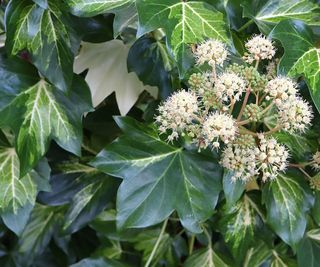
(Image courtesy of Alamy/ thrillerfillerspiller)
A cross between Fatsia and English Ivy, this versatile plant can be grown as a ground cover, shrub, or evergreen vine tied to a trellis or wire. Hardy and sturdy, this plant will brighten up shady areas with its large, leathery leaves, but it won't stretch, grow, or peel off plaster or siding like English Ivy.
They require regular watering when young plants, but once established they are very hardy, even in drought conditions. Only a few cultivars have been produced from the original hybrid that dates back to 1910, and foliage ranges from a deep lush green to variegated in shades of cream, green and gold.
Fatshedera is evergreen down to 5F and will die back if temperatures drop below this, but will quickly sprout new growth in the spring. Suitable for growing in USDA zones 7b-9b, it will grow to a height of 5 feet 6 inches.
5. Lily Turf
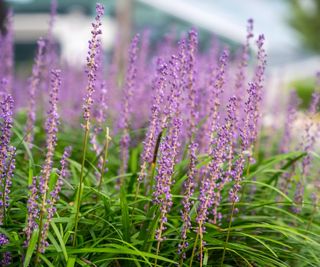
(Image credit: Lee Hyuck via Getty Images)
Liriope muscari is a pet-friendly ground cover plant with upright evergreen leaves. Also known as monkey grass, this hardy plant tolerates a wide range of growing conditions, from full sun to shade, clay to sandy soils, and moist to dry areas.
“This plant won't be eaten by rabbits or deer, making it an easy choice for anyone who wants to enjoy a garden without the hassle,” says master gardener Tabar Gifford. “Liriope muscari can be planted in large quantities as a ground cover in shady grassy areas or used to edge flower beds and walkways. Neat hills are also great for tucking in between perennials. Liriope grows comfortably in rock gardens, woodland gardens and containers. It's the perfect plant for transitioning from sun to shade.”
It produces long purple or white flower spikes in autumn followed by clusters of purplish-black berries. “Liriope is often used as a grass substitute in low-traffic areas and is great for covering soil in shady areas where grass won't grow,” adds Tabar.
It's easy to grow in USDA hardiness zones 5 through 10. Knowing how and when to fertilize monkey grass will help keep it looking its best. You can find Liriope muscari seedlings at Walmart.
6. Autumn Fern
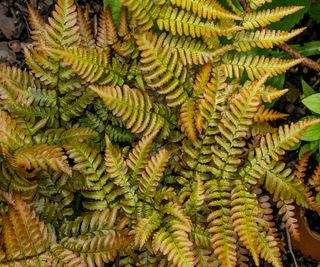
(Image courtesy of Alamy/ Bailey-Cooper Photography)
Knowing how to grow ferns is essential for creating shade-loving, drought-tolerant borders. Dryopteris ferns, also known as forest ferns, are a group of plants with erect leaf stalks, or leaves, arranged in a feathery pattern. Comprising evergreen and perennial plants, new shoots usually look like neat coils (or closures) that gradually open up to reveal leaves made up of pairs of intricately cut leaflets.
As you can see from our selection of the best ferns for shade, leaf shapes and sizes vary widely, with many changing color from rust red to gold from spring to fall. Nature Hills has a wide selection available for purchase online, including the Brilliance Autumn Fern. This fern is incredibly drought tolerant once established, and can even remain evergreen all year in hotter climates.
“We've used Dryopteris erythrosora in past projects to add an orange rust color to shade gardens,” says Elliot Rose, founder of Wildwood Landscapes. “It pairs well with other plants in the same tone, such as orange Heuchera and Wondering Chilean Iris (Libertia peregrinans), both of which work well in dry shade gardens.”

Social Links Navigation
Owner and Founder of Wildwood Landscapes
After studying landscape design and horticulture in college, Elliot opened a commercial aquaponics farm in Half Moon Bay, which led to a career in the landscape industry. Elliot worked as a construction foreman and assistant designer for a local premium design and construction firm before opening Wildwood Landscapes. Elliot brings his passion for design and technical background in construction to every project, guiding his clients from the first site visit to the perfect installation.
7. Astilbe
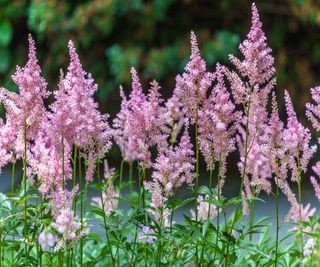
(Image courtesy of Alamy/ Botany vision)
This compact, low-maintenance perennial provides year-round enjoyment with its fluffy flower spikes, spectacular seed heads and deeply lobed leaves. Annual flowering plants do best in shade and are known to thrive in moist environments, although some varieties can tolerate much drier conditions once established.
“Astilbe chinensis, especially the 'Visions' series, is a shade-loving perennial that's easy to grow and more drought tolerant than other astilbe varieties,” says Tabar Gifford. This variety of astilbe grows best in USDA hardiness zones 4 through 8.
“It grows well in shady locations and produces bright, feathery flowers in a variety of colors. The flowers rise above a mound of fern-like leaves, making it attractive all season long and adding texture to shady gardens and flower beds.” The plant is also resistant to deer, rabbits, and most pests.

Social Links Navigation
Master Gardener
Tabor Gifford, Customer Experience and Partnership Cultivator at American Meadows, is a Master Gardener and avid “plant nerd.” With a lifelong love of gardening and nature and a background in environmental studies and sustainable community development, she combines her horticultural expertise with a commitment to education. Striving to help individuals realize their gardening dreams, Tabor embodies a genuine passion for sharing her knowledge.
8. Chinese Wild Ginger
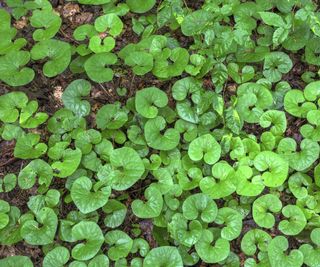
(Image credit: Getty Images/CarbonBrain)
A shade-friendly perennial ground cover plant, Chinese wild ginger or Asarum splendens grows well in USDA zones 2 through 8. This attractive plant is highly drought tolerant and forms a carpet of mottled green, heart-shaped leaves that grow to just 6 to 8 inches tall.
Its dense foliage suppresses weeds, provides refuge for insects and small mammals, and also hides rare earth-toned flowers that bloom from April through to June.
The plant is deer and rabbit resistant, spreads by shallow rhizomes, is poisonous if eaten, and has a slightly spicy scent that makes it an effective slug repellent.
If you'd like more tips and advice on managing shady areas of your garden, check out our guide to ground cover plants that are good for shade and the best shrubs for shade.


